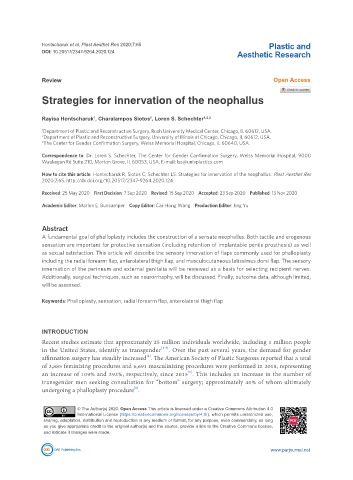Page 764 - Read Online
P. 764
Hontscharuk et al. Plast Aesthet Res 2020;7:65 Plastic and
DOI: 10.20517/2347-9264.2020.124 Aesthetic Research
Review Open Access
Strategies for innervation of the neophallus
Rayisa Hontscharuk , Charalampos Siotos , Loren S. Schechter 1,2,3
1
1
1 Department of Plastic and Reconstructive Surgery, Rush University Medical Center, Chicago, IL 60612, USA.
2 Department of Plastic and Reconstructive Surgery, University of Illinois at Chicago, Chicago, IL 60612, USA.
3 The Center for Gender Confirmation Surgery, Weiss Memorial Hospital, Chicago, IL 60640, USA.
Correspondence to: Dr. Loren S. Schechter, The Center for Gender Confirmation Surgery, Weiss Memorial Hospital, 9000
Waukegan Rd Suite 210, Morton Grove, IL 60053, USA. E-mail: lss@univplastics.com
How to cite this article: Hontscharuk R, Siotos C, Schechter LS. Strategies for innervation of the neophallus. Plast Aesthet Res
2020;7:65. http://dx.doi.org/10.20517/2347-9264.2020.124
Received: 25 May 2020 First Decision: 7 Sep 2020 Revised: 15 Sep 2020 Accepted: 23 Sep 2020 Published: 13 Nov 2020
Academic Editor: Marlon E. Buncamper Copy Editor: Cai-Hong Wang Production Editor: Jing Yu
Abstract
A fundamental goal of phalloplasty includes the construction of a sensate neophallus. Both tactile and erogenous
sensation are important for protective sensation (including retention of implantable penile prosthesis) as well
as sexual satisfaction. This article will describe the sensory innervation of flaps commonly used for phalloplasty
including the radial forearm flap, anterolateral thigh flap, and musculocutaneous latissimus dorsi flap. The sensory
innervation of the perineum and external genitalia will be reviewed as a basis for selecting recipient nerves.
Additionally, surgical techniques, such as neurorrhaphy, will be discussed. Finally, outcome data, although limited,
will be assessed.
Keywords: Phalloplasty, sensation, radial forearm flap, anterolateral thigh flap
INTRODUCTION
Recent studies estimate that approximately 25 million individuals worldwide, including 1 million people
in the United States, identify as transgender [1-3] . Over the past several years, the demand for gender
[4]
affirmation surgery has steadily increased . The American Society of Plastic Surgeons reported that a total
of 2,885 feminizing procedures and 6,691 masculinizing procedures were performed in 2018, representing
[5]
an increase of 109% and 392%, respectively, since 2015 . This includes an increase in the number of
transgender men seeking consultation for “bottom” surgery; approximately 40% of whom ultimately
[6]
undergoing a phalloplasty procedure .
© The Author(s) 2020. Open Access This article is licensed under a Creative Commons Attribution 4.0
International License (https://creativecommons.org/licenses/by/4.0/), which permits unrestricted use,
sharing, adaptation, distribution and reproduction in any medium or format, for any purpose, even commercially, as long
as you give appropriate credit to the original author(s) and the source, provide a link to the Creative Commons license,
and indicate if changes were made.
www.parjournal.net

